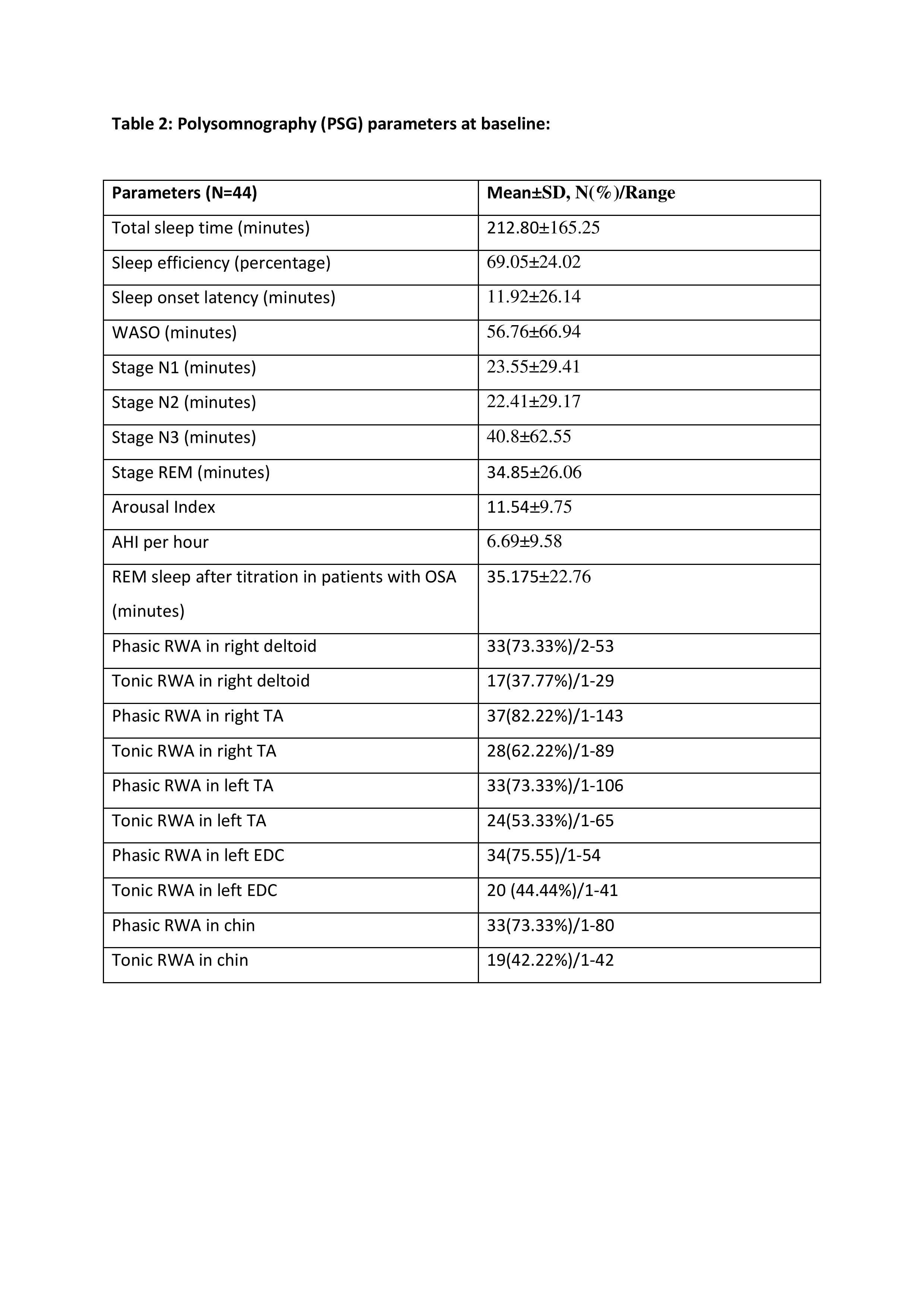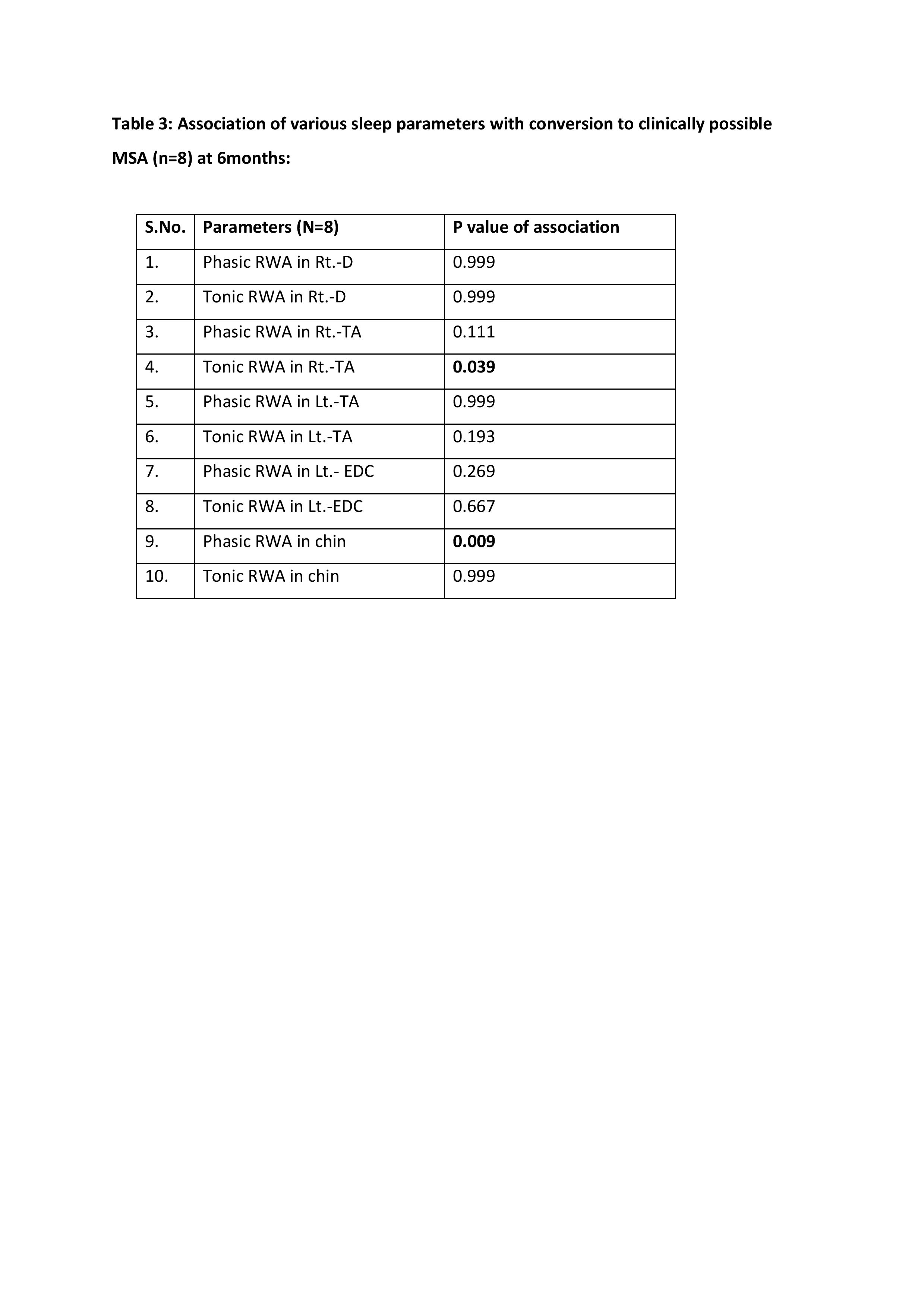Category: Ataxia
Objective: To evaluate the occurrence of rapid eye movement behavioral disorder (RBD) and associated polysomnographic abnormalities in patients of sporadic adult onset ataxia
Background: Sporadic adult-onset ataxia with unknown etiology (SAOA) are a group of disorders which present as slowly progressive ataxias with median survival of 21 years.1 In progressive adult-onset non-familial ataxias, one group is SAOA. Various studies suggest that a proportion of patients (3.8% to 24%) with SAOA can convert into MSA-C within 4-5 years.
The other group is multiple system atrophy- cerebellar (MSA- C).2 However, 5-24% patients with SAOA will evolve to MSA in a time –span of 4-5 years as shown in some studies.3,4
Till date, there is no study on SAOA elucidating the presence of RBD and associated polysomnographic findings.We aim to determine the occurrence of RBD along with polysomnographic abnormalities in a cohort of SAOA patients. There is a possibility that those SAOA with spontaneous RBD will evolve into MSA-C in future.
Method: The results are a part of interim analysis of the ongoing cohort study “Evaluation of rapid eye movement (REM) behavioral disorder in sporadic adult onset ataxia (SAOA)- A prospective observational study” funded by ICMR, Govt of India. Intervention:Enrolled patients were subjected to clinical examination and a set of questionnaires and tests (SARA scale, MOCA scale, RBDSQ questionnaire and COMPASS- 31 questionnaire). The subjects underwent polysomnography and autonomic function tests. The patients were followed up every 6 monthly to see for the progression of the disease/associated symptoms through these questionnaires.
Results: A total of 45 patients have been enrolled in the study till now. Of them, 23 have completed their 6 months follow-up while 13 patients have completed their one-year follow-up.
Table 1 denotes the polysomnographic parameters of patients enrolled in the study.Table 2 shows the association of various sleep parameters with conversion to clinically possible MSA (n=8) at a duration of 6 months.
Conclusion: Polysomnographic features of RBD like RWA may be present in fairly large proportion (1/3 to 4/5th) of patients with SAOA at baseline. Baseline polysomnographic abnormalities like tonic RWA in tibialis anterior and phasic RWA in chin may predict this development at six months of follow-up. Further studies with higher sample size needs to replicate these findings.
Table 1
Table 2
References: 1. Klockgether T. Sporadic adult-onset ataxia. Handb Clin Neurol. 2018;155:217-225. doi: 10.1016/B978-0-444-64189-2.00014-7.
2. Palma JA, Norcliffe-Kaufmann L, Kaufmann H. Diagnosis of multiple system atrophy. AutonNeurosci. 2018 May;211:15-25. doi: 10.1016/j.autneu.2017.10.007
3. Giordano I, Harmuth F, Jacobi H, Paap B, Vielhaber S, Machts J, Schöls L, Synofzik M, Sturm M, Tallaksen C, Wedding IM, Boesch S, Eigentler A, van de Warrenburg B, van Gaalen J, Kamm C, Dudesek A, Kang JS, Timmann D, Silvestri G, Masciullo M, Klopstock T, Neuhofer C, Ganos C, Filla A, Bauer P, Tezenas du Montcel S, Klockgether T. Clinical and genetic characteristics of sporadic adult-onset degenerative ataxia. Neurology. 2017 Sep 5;89(10):1043-1049. doi: 10.1212/WNL.0000000000004311.
4. Gilman S, Little R, Johanns J, Heumann M, Kluin KJ, Junck L, Koeppe RA, An H. Evolution of sporadic olivopontocerebellar atrophy into multiple system atrophy. Neurology. 2000 Aug 22;55(4):527-32.
To cite this abstract in AMA style:
A. Das, A. Jaryal, A. Srivastava. Spectrum of polysomnographic abnormalities in a cohort of sporadic late onset ataxia patients [abstract]. Mov Disord. 2024; 39 (suppl 1). https://www.mdsabstracts.org/abstract/spectrum-of-polysomnographic-abnormalities-in-a-cohort-of-sporadic-late-onset-ataxia-patients/. Accessed December 12, 2025.« Back to 2024 International Congress
MDS Abstracts - https://www.mdsabstracts.org/abstract/spectrum-of-polysomnographic-abnormalities-in-a-cohort-of-sporadic-late-onset-ataxia-patients/


